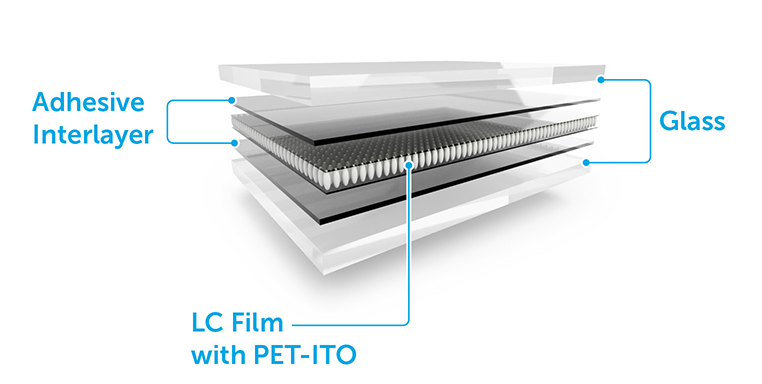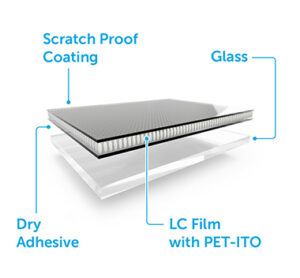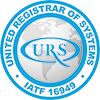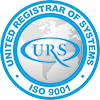Everything You Want to Know About
Smart Glass
Smart glass, also called LCG® (light control glass), switchable glass or smart privacy glass, is helping to define the architectural, automotive, interior, and product design industries.
In the simplest definition, smart glass technologies alter the amount of light transmitted through typically transparent materials, allowing these materials to appear as transparent, translucent, or opaque. The technologies behind smart glass help resolve the conflicting design and functional demands for balancing the benefits of natural light, views, and open floor plans with the need for energy conservation and privacy.
This guide is intended to aid your research and decision-making process about implementing electric switchable glass or smart glass technology into your next project, or including it to your products and services.
What Is Smart Glass?
Smart glass is dynamic, allowing a traditionally static material to become alive and multifunctional. This technology allows for the control of various forms of light including visible light, UV, and IR. Smart privacy glass products are based on technologies that allow transparent materials (like glass or polycarbonate) to switch, on demand, from clear to shaded or completely opaque.
The smart switchable glass technology can be integrated into windows, partitions and other transparent surfaces in various sectors, including architecture, interior design, automotive, smart retail windows, and consumer electronics.
There are two primary types of smart glass: active and passive.
These are defined by whether or not their changeability requires an electrical charge. If so, it’s categorized as active. If not, it’s categorized as passive.
The term smart glass mainly refers to active technologies in which privacy glass films and coatings, activated by an electrical charge, change the appearance and functionality of the glass.
Types of active switchable glass technologies and their common applications include:
• Polymer Dispersed Liquid Crystal (PDLC) glass, eg: typically seen in privacy partitions in various industries
• Suspended Particle Device (SPD) glass, eg: windows that tint to shade as seen in automotive and buildings
• Electrochromic (EC) glass, eg: coated windows that slowly tint for shading
The following are the two passive smart glass technologies and common applications for each:
• Photochromic glass, eg: eyeglasses with coatings that automatically tint in sunlight.
• Thermochromic glass, eg: coated windows that change in response to temperature.
Synonyms for smart glass include:
LCG® – light control glass | Electric Switchable glass | Smart tint | Tintable glass | Smart Privacy glass | Dynamic glass
The technologies that allow you to instantly switch surfaces from transparent to opaque are the ones referred to as Privacy Smart Glass. They are particularly popular for glass-walled or partitioned conference rooms in agile workspaces based on open floor plans, or in hotel guestrooms where space is limited and traditional curtains ruin design aesthetics.
How Smart Glass Works
Active smart glass technology allows for the control of various forms of light (visible, IR, UV) with electricity. With electricity, glass is switched from opaque to transparent, allowing for dynamic light control.
PDLC and SPD smart glass technology is an active glass technology that switches states with electricity. The unique particles or molecules inside our films scatter or align as films are turned on and off, allowing light to pass through for opacity or transparency, and the switchable control of various forms of light (visible, IR, UV).
Three terms you’ll hear a lot in discussions about privacy glass are the types of active light control technologies:
• Polymer Dispersed Liquid Crystal (PDLC)
• Suspended Particle Device (SPD)
• Electrochromic Device (ECD)
Smart glass using PDLC or SPD includes a film interlayer that is either laminated or retrofitted onto glass. This film interlayer consists of a PDLC formulation, or an SPD emulsion, that is coated between two sheets of transparent materials that each have an ITO conductive coating. When electricity is applied, the ITO conductive coating forces the molecules or particles in the chemical layer of the film to align, creating transparency.
While PDLC and SPD are most commonly applied to films, electrochromic products are coated directly onto ITO conductive glass.
One key trait all three technologies share is the ability to change the transparency of glass through polarization (a uniform lining up) of their molecules or particles inside the formulation (PDLC) or emulsion (SPD). When off (absence of voltage), the molecules are randomly scattered, and therefore, light cannot pass through the film. When charged, the LC formulation or SPD emulsions polarize, and the molecules align, allowing light to pass through, creating transparency. As voltage decreases, and the film starts turning off, varying levels of opacity are achieved for dynamic shading, privacy, or IR solar light control. A dimming effect can be achieved by controlling the amount of voltage that is applied. In contrast, electrochromic smart glass never goes completely opaque and becomes clear when there is no current and it depolarizes.
Switchable glass technologies use either transformers or controllers to manage power. Controllers can maintain a continuous charge, but transformers have to be turned off for part of the day. The following video demonstrates a variety of controllers used for exhibits at the 2018 Glasstec Trade Fair.
Smart Glass Technologies
Polymer Dispersed Liquid Crystal (PDLC)
The technology behind PDLC films used to create smart glass contain liquid crystals, a material that shares characteristics of both liquid and solid compounds, which are dispersed into a polymer.
Switchable smart glass with PDLC is one of the most commonly used technologies. While this type of film is generally used for indoor applications, PDLC can be optimized to maintain its properties in outdoor conditions. PDLC is available in colors and patterns. It is generally available in both laminated (for newly fabricated glass) and retrofit (for existing glass) applications.
PDLC switches glass from dimmable degrees of opaque to clear in milliseconds. When opaque, PDLC is ideal for privacy, projection, and whiteboard use. PDLC usually blocks visible light. However, solar reflective products, such as the one developed by the material science company Gauzy, allows for IR light (which creates heat) to be reflected when the film is opaque.
In windows, simple PDLC limits visible light, but does not reflect heat, unless optimized otherwise. When clear, PDLC smart glass has excellent clarity with a minimum of 2.5 haze depending on the manufacturer. In contrast, Outdoor Grade Solar PDLC cools indoor temperature by deflecting infrared rays, but does not shade windows. PDLC is also responsible for the magic that enables glass walls and windows to become a projection screen or a transparent window instantly.
Because PDLC is available in a variety of types (white, colors, projection support, etc), it is ideal for multiple applications across diverse industries.
Suspended Particle Device (SPD)
SPD contains miniscule solid particles which are suspended in liquid and coated between two thin layers of PET-ITO to create a film. It shades and cools interiors, blocking up to 99% of incoming natural or artificial light within seconds of shifting voltage.
Like PDLC, SPD can be dimmed, allowing for a customized shading experience. Unlike PDLC, SPD does not turn completely opaque, and therefore, is not suited for privacy, nor is it optimized for projection.
SPD is ideal for exterior, sky or water facing windows and can be used in indoor applications as well, where darkness is required. SPD is manufactured by only two companies in the world.
Electrochromic Device (ECD)
Electrochromic privacy glass filters both the light and heat of solar rays. The technology behind ECD differs from PDLC and SPD impacting both its opacity capabilities and transition time.
ECD uses two electrodes to drive ionized particles from the “inside” of the glass (transparent) to the “outside” (opaque). Once the particles have moved, no current is required for them to stay at the current state. This impacts transition time to a gradual speed from its outdoor edges, inward and full transition can take several minutes or more, depending on the size of the glass.
Electrochromic switchable glass is ideal for exterior applications like energy-conserving windows, but not for privacy glass as it does not have the capability to turn completely opaque. The below graphic demonstrates how each technology works.
PDLC
SPD
Electrochromic
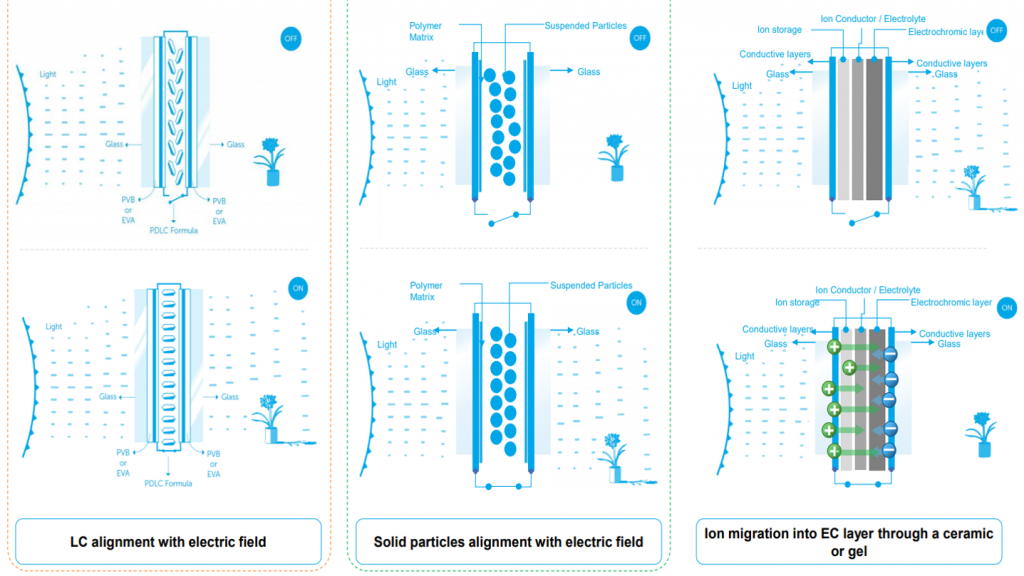
Smart Glass Applications
Architects, Interior Designers, and Automotive Companies regularly use smart glass in:
- 1 Office Partitions
- 2 Hotels
- 3 Hospitals
- 4 Residential
- 5 Retail
- 6 Automotive
Switchable Glass Office Partitions
Electrically switchable glass partitions and walls add adaptability and give a “WOW” effect to interior office designs. Switchable glass can easily transform a space from open and shared, to private and intimate, and anywhere in between with dimming features.
This is especially helpful in agile work environments based on flexible open floor plans. An ideal solution to support minimalist interior design while maintaining privacy and maximizing the space of a modern office.
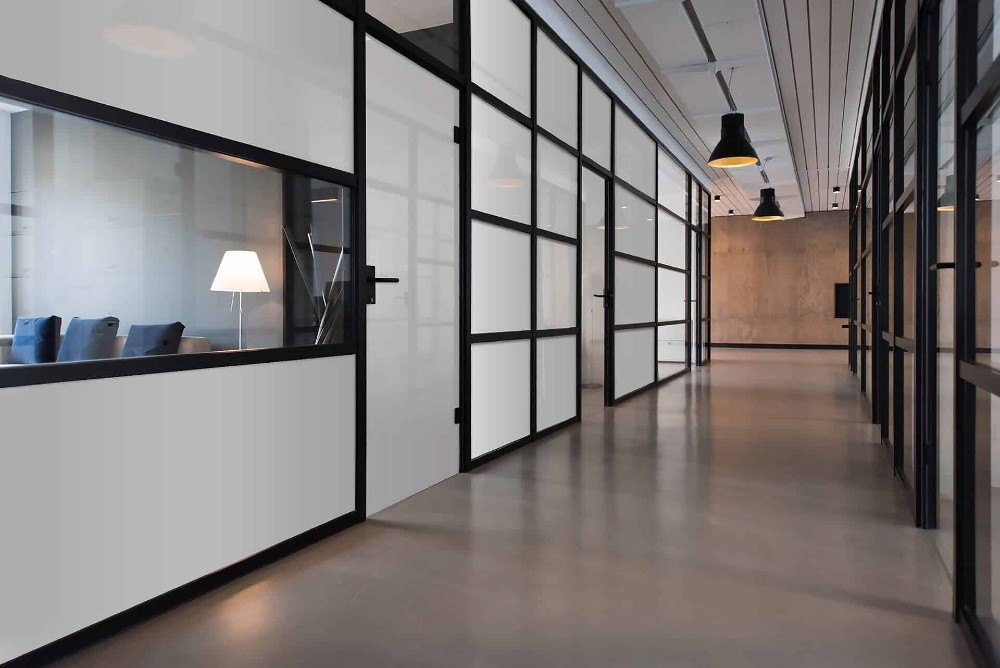
Smart Glass In Hotel Guest Rooms
Elegance and efficiency are hallmarks of PDLC smart glass in hotel guest rooms as this technology offers an ideal solution for including a cozy lounging and sleeping space, clean and relaxing bathroom, and privacy for intimate moments in a way that feels spacious within limited square footage.
LCG with PDLC can also be seen in micro hotels, hotel lobbies and common areas when paired with projection, and for privacy in bathrooms, and spas, but is most commonly used for bathroom enclosures in guest rooms. With a simple click, the guest transforms the electronic privacy glass from clear to opaque and back again.
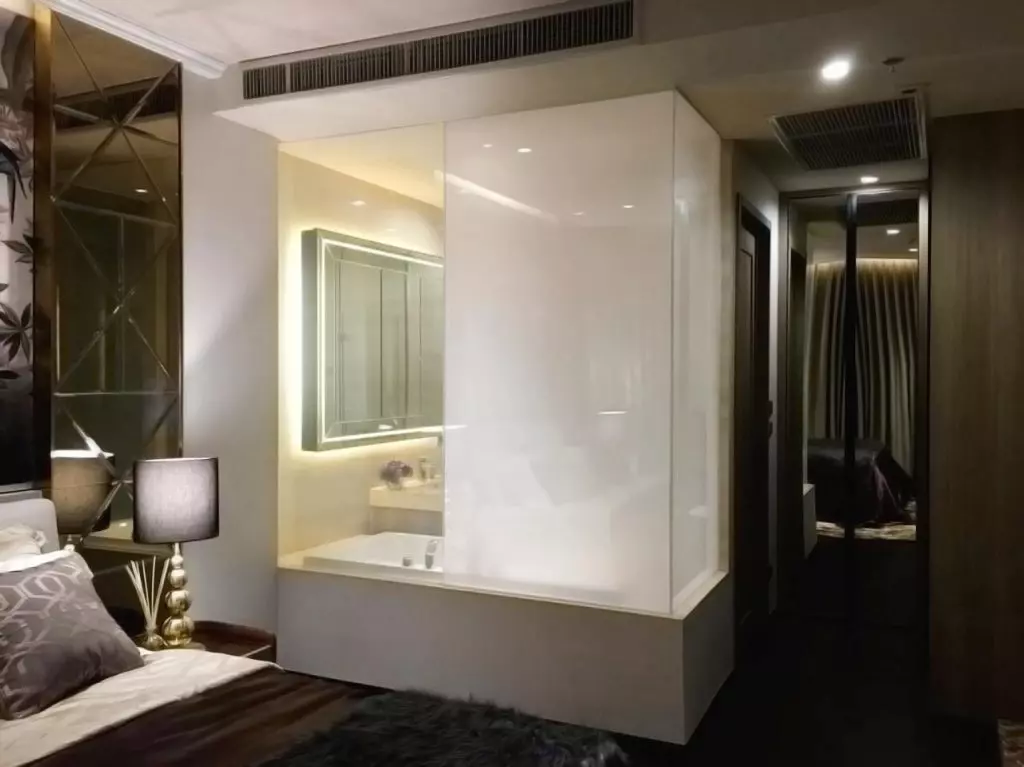
Electric Smart Glass In Hospital Rooms
Smart glass is eliminating the need for traditional drapery and curtains, a valuable feature for hospitals and medical facilities. Research shows that patient-privacy curtains harbor bacteria responsible for spreading disease. Moreover, glass hospital room partitions better isolate sound, creating an extra layer of confidentiality.
One of the industry pioneers to take advantage of this is Tel Aviv’s Dana-Dwek Children’s Hospital, which replaced its ICU interior drapery with switchable glass based on PDLC. With PDLC partitions, hospital staff can check on patients without entering a room, reducing disturbances and chances of contamination and improving the overall patient recovery process.
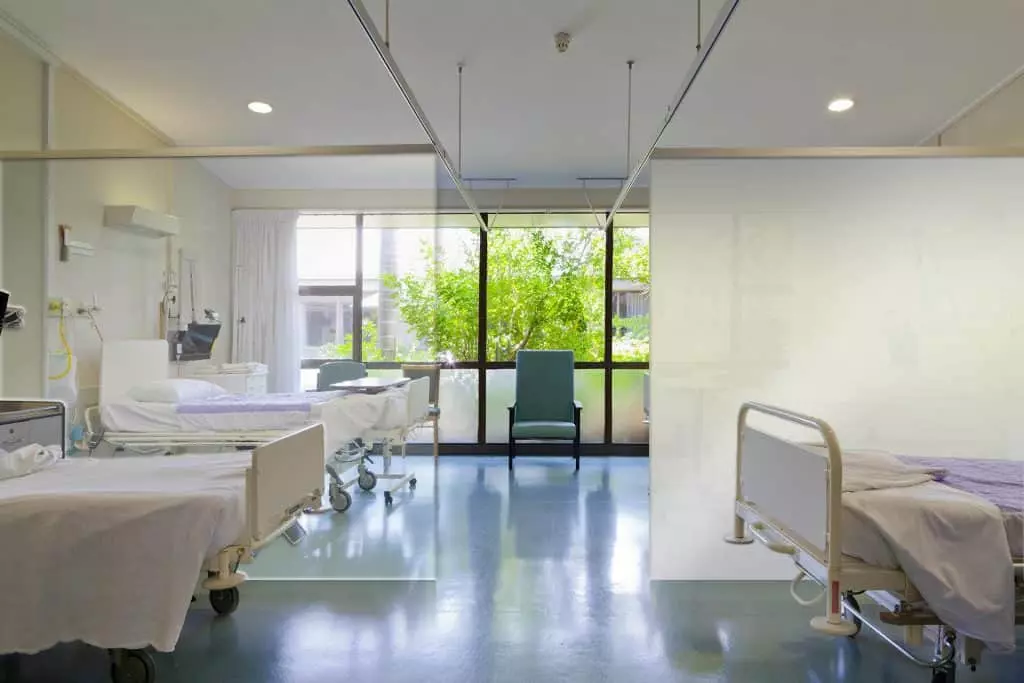
Residential Switchable Glass Windows
Switchable glass windows, doors, and partitions are beginning to appear in the residential sector. To make homes more energy efficient, solar control PDLC can be used to reduce IR light which creates heat, and SPD can be used to shade, both keeping spaces cool and lowering HVAC costs.
High Temp LCG Films can be used on LC based switchable glass for outdoor applications and exterior windows that face the street or neighbors, so privacy can be achieved without the need for curtains or blinds.

Switchable Glass Retail Storefront Windows
Smart visual merchandising allows retailers to take full advantage of their store’s most valuable real estate. Smart glass technology allows 100% utilization of storefront windows for advertising or can be made completely transparent to allow views into a store. A retailer’s windows can become rear-projection screens promoting retail branding and products without permanently blocking windows with traditional signage or tv screens.
Projection has numerous advantages for retail use – it replaces stickers that take time to produce and install properly; replaces TV’s that block views, and can be paired with software for uniform branding for global brands that is also geographic specific, making messaging more targeted and consumer friendly.

Smart Glass Automotive Windows
Smart glass is rapidly becoming the smartest choice for dynamic shading and temperature control in the transportation sector. Smart Glass with SPD allows clear views through windows and sunroofs, while minimizing solar rays that cause glare, skin damage, and deterioration of interiors.
Automotive (including aeronautics and trains) switchable glass supports: temperature control, protection of interiors from degradation/discoloration from UV ; dimmable shading in all windows to reduce blinding glare, projection applications for digital signage, and security in armored vehicles.

Check out blogs focused on smart glass applications
Which Smart Glass Do I Need?
Each privacy smart glass technology has it’s pros, cons and ideal applications.
Outdoor windows are most likely to use SPD, EC, or a solar control PDLC while interior privacy or projection partitions are specific to PDLC. Interior SPD partitions are mainly relevant for rooms that need darkness (TV stations, ultrasounds), and EC is only desirable for facade windows that do not require instant tinting due to slow transition times.
Deciding which type of smart glass is right for your project or application may seem daunting. For this reason we’ve created a table to help clarify the choices and how they can be applied to maximize your space.
| Which? | Why? | Where? |
|---|---|---|
| PDLC (Indoor) | Offers privacy without blocking light. Transitions quickly. | Interior privacy partitions and transparent displays |
| PDLC (outdoor) | Special solar variations can control IR (heat) which can enter from sunlight, without blocking light. These transitions quickly improve energy ratings for green buildings. | Exterior windows, interior glass walls, and interior privacy partitions |
| SPD | Allows glass to turn on, off, or dim to block up to 99% of light for high performance glazing that replaces traditional shading solutions. | Skylights, facade windows, cars, trains and aeronautics, TV Studios, ultrasound rooms, and galleries where art can be damaged by sun exposure |
| EC | Blocks light, and transitions slowly. | Large or small facade windows where instant shade is not required |
Smart Glass Application Methods
Smart Glass “Intelligence” is applied in two ways:
- Lamination of films (PDLC and SPD) and coatings (electrochromic) between panes of glass
- Retrofitting PDLC film to existing windows.
Laminated PDLC or SPD privacy glass is durable. It withstands elements such as humidity, as well as excessive cleaning and high volume use. It is ideal for new construction or renovation projects in which glass can be replaced.
In lamination, a glass fabricator cuts a sheet of PDLC or SPD film and seals it between two panes of glass. Production takes an average of about four weeks depending on supplier. Then a glazier or partition company installs the glass, and an electrician connects it to the power source. Installation time depends on project size and the installer’s schedule.
Retrofit PDLC switchable glass should be applied by a professional installer and adhered to the surface of glass with either wet or dry adhesive. The wet kind is the easiest to adjust. Retrofitting is helpful when glass can’t be replaced or in cases where glass needs to be thinner than a double pane.
Smart Glass Cost and Benefits
Providing a general price estimate without taking certain consideration into account is not possible. Included in pricing considerations: which technology, what type of glass, thickness, and if there is additional processing or coating required. Depending on who you purchase from, a direct manufacturer or reseller, quantity and territory, prices will vary.
According to the home improvement website, Modernize, smart glass costs about 50% more than regular windows. However, Modernize notes that it has the potential to save a building owner 20% of energy costs.
Furthermore, the ROI on smart glass use in office buildings is twofold. Not only is payback reported over time, offices that utilizes smart glass technology can gain LEED certification, while improving employee comfort and productivity.
Want to use switchable smart glass in an upcoming project? Talk to Gauzy’s smart glass experts and get a quote today!
The Future of Smart Glass
The use of active smart glass technologies, which began in the early 2000s, is rapidly increasing in various industries such as automotive, construction, and interior design.
This growth is due to the improved quality of switchable glass technologies as well as energy conservation awareness. It’s also based on design needs — both in vehicles and buildings — requiring quick adaptability from clear transmission of light to private or shaded opacities.
Privacy glass trends that are likely in the next decade include:
1. Greater accessibility
Smart glass will become the standard for control of light and temperature in quality automobiles as well as building windows, particularly in commercial real estate.
2. Increased use in building interiors and exteriors
Smart glass walls and partitions will grow as a product for flexible open-space design, emphasizing room dividers that switch from clear to opaque. This will meet competing demands for access to natural light and privacy. With the introduction of architectural-grade SPD, facades windows and skylights will become smart glass.
3. Broader applications
Smart glass will expand into the design of objects, such as home appliances and other commercial goods.
Who Manufactures and Delivers Smart Glass?
Only a few manufacturers of privacy glass also develop the actual PDLC or SPD technology inside a smart glass film. Material science and research and development companies are responsible for such types of work.
Glass fabricators or glass processors may purchase film directly from PDLC and SPD manufacturers to laminate and fulfill switchable glass needs for clients. The fabricator cuts and laminates the film based on architectural specifications. The specs should (1) include directions for polishing and tempering the glass, (2) identify the type of privacy glass film and other laminating materials to use, and (3) name the source for such smart glass.
Following an order for switchable glass, it generally takes about six weeks before an installer may receive the glass to a site. Installation may take one or more days. It includes connection of wiring by an electrician and framing of the glass.
How to Specify Smart Glass in Architectural Plans
Preparing smart glass product specifications for architectural plans is a three-step process, involving investigation, research and selection of available products along with choice of supplier.
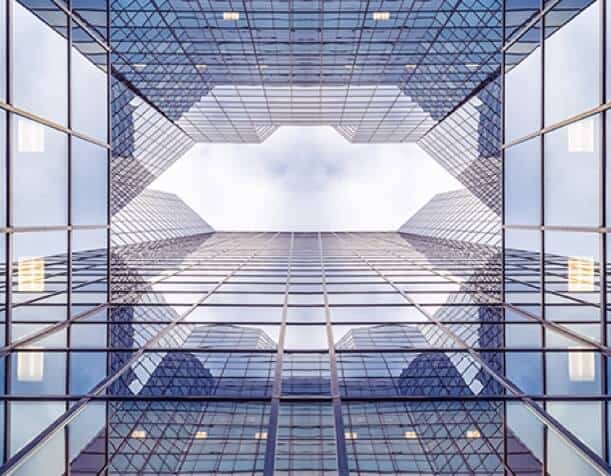
3 Easy Steps
1. Investigate types of smart glass and controllers available, because function affects selection. For example, does the project need smart glass for exterior windows, doors, or indoor partitions?
Some choices require shading or reflection of solar heat, while others call for opaque privacy and transparent display applications.
2. Based on this research, state the type and brand of product in the specs.
3. Identify a certified smart glass supplier, which may be a manufacturer or a reseller of a manufactured product.
If specifications simply notes “smart glass” you may end up with a product irrelevant to your project. In a case where this information is missing, leave the product and supplier selection to a general contractor or a subcontractor to investigate further. The best solution is to always say which smart glass manufacturer you want.
Glossary of Smart Glass Terminology
Active Smart Glass
A product that changes appearance and function in response to on/off electrical charges to conductive films or coatings
Controller
A device that can deliver electricity to smart glass continuously using dimmers to switch appearance from transparent to tinted or opaque
Dynamic Glass
A changeable glass product that relies on active electrical charges, or passive (non-electrically charged) stimuli
Electrochromic Glass
An active smart glass primarily used for facade windows made of formulations coated directly onto glass
LCG
Light control glass, which contains electrically conductive crystals or molecules that shift between a liquid and solid state
LCG
The Gauzy registered trademark meaning “Light Control Glass” and related to patented liquid crystal and SPD film products
Outdoor Grade PDLC Film
Electrically conductive polymer dispersed liquid crystal film for windows that controls heat but not light, only available by certain manufactuers
Passive Smart Glass
Photochromic and thermochromic glass treated with coatings that respond to solar rays
PDLC Film
An electrically conductive film that controls light but not heat and which contains polymer dispersed liquid crystals
Photochromic Glass
A coated glass mostly used in eyewear that filters visual light
Polarization
A uniform lining up of molecules in light-controlling materials, such as liquid crystals, to filter or block light
Privacy Glass
Smart glass that can turn opaque
Rear Projection Window
Display windows containing PDLC film that conduct images and colors projected from a rear compatible projector
Laminated PDLC Film
PDLC film produced by a manufacturer, that is laminated between sheets of glass with adhesive interlayers by a glass fabricator
Retrofit PDLC Film
PDLC film applied directly to a piece of existing glass with dry or wet adhesive
Simple PDLC
Switchable PDLC film that manipulates light but not heat
Smart Glass
Glass containing electrically conductive substances that alter its appearance and function in response to changes in voltage
Smart Tint
Another name for kinds of smart glass that change appearance in response to electricity
SPD Film
Suspended particle device film for smart glass that cools and shades interiors when conductive, nano-sized, solid particles floating in liquid respond to an electrical charge
Switchable Glass
Smart glass that changes appearance and function in response to electricity
Thermochromic Glass
Passive dynamic glass used in windows to control solar heat
Tintable Glass
Smart glass (also called switchable or privacy glass) that changes appearance and function in response to electricity


